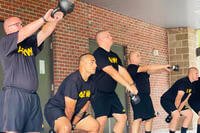This is the first of a series of pool confidence workouts you should get comfortable doing if your future involves military scuba diving or rescue swimming. A certain level of water confidence needs to be developed by those wishing to be successful with any of the assessment and selection programs the military special operations/special warfare communities offer.
When selecting swim workouts to do, pick the options that you are the most uncomfortable doing. The No. 1 rule is never to practice any of these drills alone. Either swim in a pool with a lifeguard or have a partner swimming alongside you, especially when under water.
The 25-75 Tread or Bounce Workout
This workout focuses on underwater swimming techniques, treading or bottom bouncing events, drownproofing and conditioning. The goal is not how long you can hold your breath, but how efficiently you can get to the other side of the pool (in as few strokes as possible).
For reference, swimmers can usually do 25 meters underwater in 3-4 strokes, while above-average, non-swimming athletes can get 4-6 strokes per 25 meters. If you are doing more than six strokes to get across the pool, you should work more on your stroke, kick power and streamlining your body position than breath-holding drills.
Here is how the workout is structured:
The workout: Start with a one- to two-minute tread (no hands) or bottom bounce (hands behind back), then using the wall to kick off, swim underwater to the end of the pool if it is 20-25 meters in length. Then swim the freestyle, breaststroke or the combat swimmer stroke (CSS) for 75 meters. Rest with 1-2 minutes of treading or bottom bouncing. Repeat this 5-10 times, depending on your abilities.
Rest with tread or bounce: Most people fall into one of two camps. You find treading difficult because you have lean body mass and do not float well, or bottom bouncing difficult because you are not lean and do not sink well without complete exhalation of the lungs. Depending on your body type, one of these options will be easy and the other difficult.
The goal of this workout is to "rest" with your most difficult activity, but you can work both if you prefer doing odd sets of bouncing and even sets of treading. See this bottom bounce video rest 1-2 minutes done between each set.
25-meter underwater swim: The key to swimming underwater is efficiency. How many pulls and kicks does it take to get to the other side of the pool? The goal is to do it in as few strokes as possible, meaning you must have your streamlined glide position locked in. Once you have that down and you can do the 25-meter distance in 4-5 strokes, the 25-meter distance will feel easier than holding your breath and walking. See the video of underwater into the 75-meter swim part of the workout.
75-meter conditioning swim: How you swim this 75-meter section is up to you. My advice is to use this as an opportunity to add conditioning to the pool skills above and select the stroke on which you will be tested. Depending on your choice of programs, you can swim either the CSS, elementary side stroke, breaststroke or freestyle/crawl stroke.
Build up to 5-10 sets: Repeat 5-10 times, depending on your swim ability. You may need a little more rest than the active rest of the bottom bounce. Most people do. Take it if you need it and continue doing the sets above as many times as possible. Eventually, the treading and/or bottom bounce rest will prove to be enough recovery for you.
Just as you have to put in the miles to get better at running, you also need to put in the time in the pool. This is the process of mastering the technique and getting into the level of swimming conditioning (swimming shape) needed to become a competent swimmer.
Stew Smith is a former Navy SEAL and fitness author certified as a strength and conditioning specialist (CSCS) with the National Strength and Conditioning Association. Visit his Fitness eBook store if you're looking to start a workout program to create a healthy lifestyle. Send your fitness questions to stew@stewsmith.com.
Want to Learn More About Military Life?
Whether you're thinking of joining the military, looking for fitness and basic training tips, or keeping up with military life and benefits, Military.com has you covered. Subscribe to Military.com to have military news, updates and resources delivered directly to your inbox.























